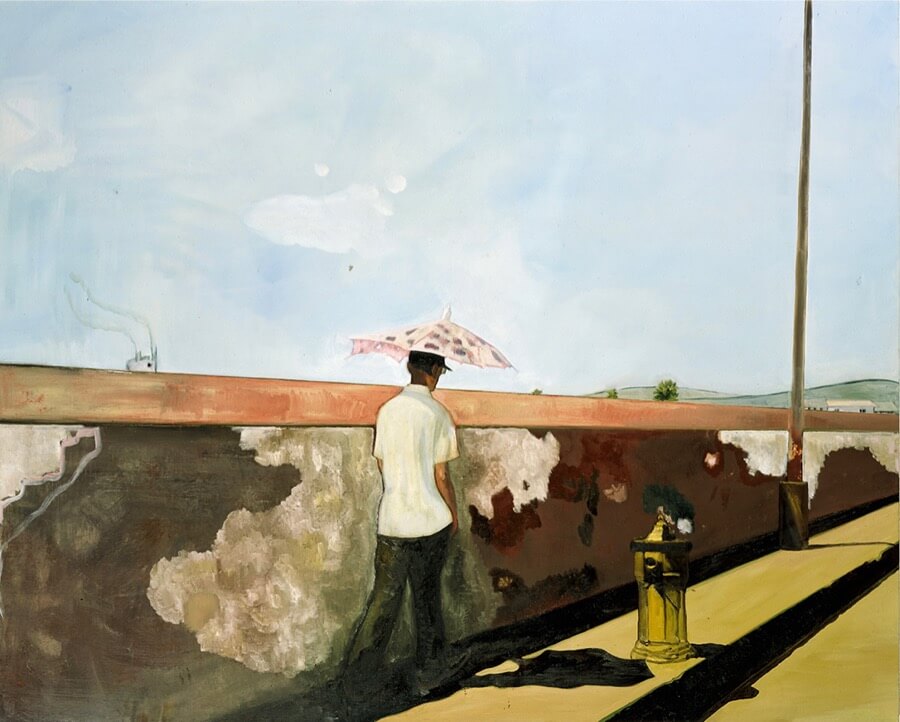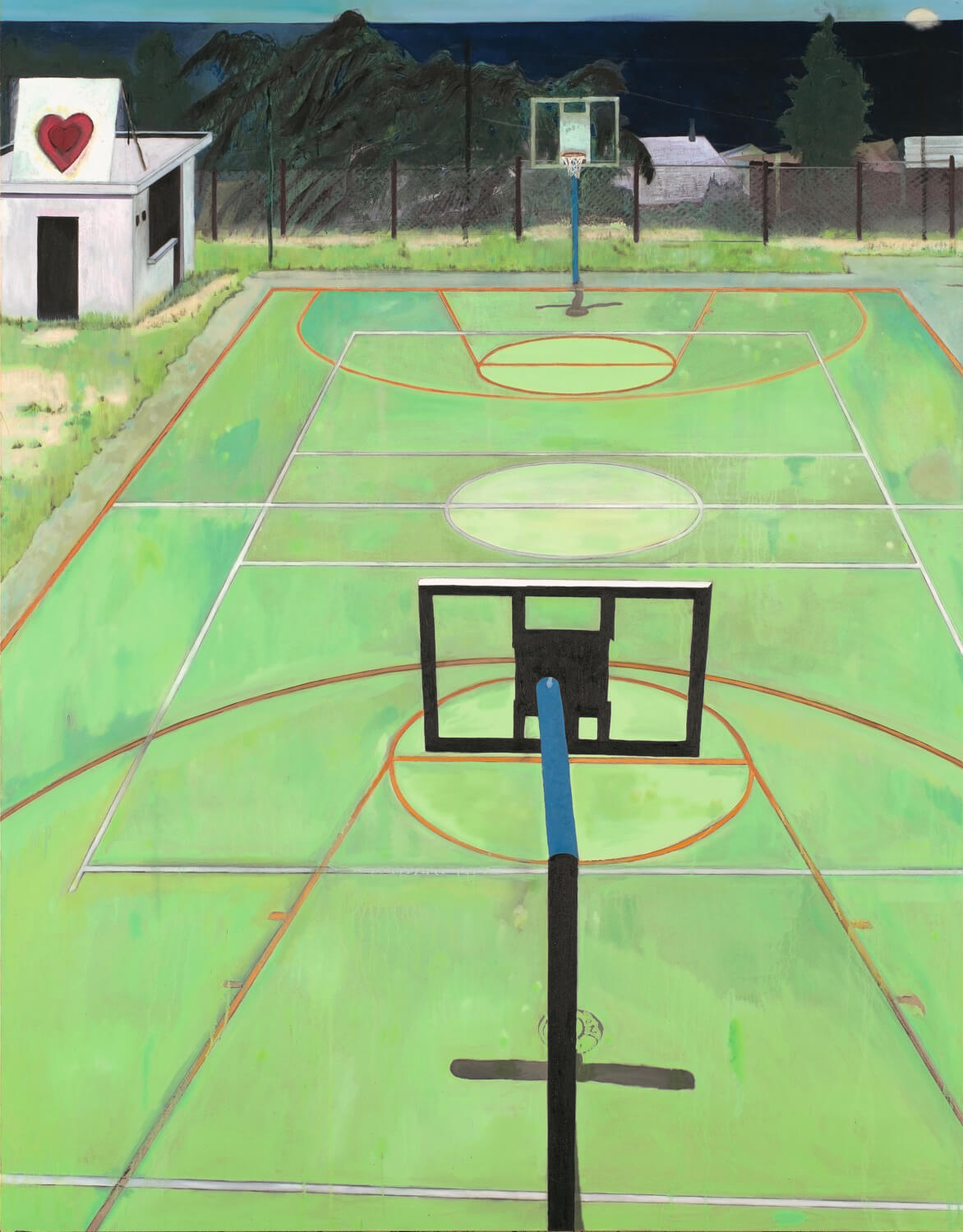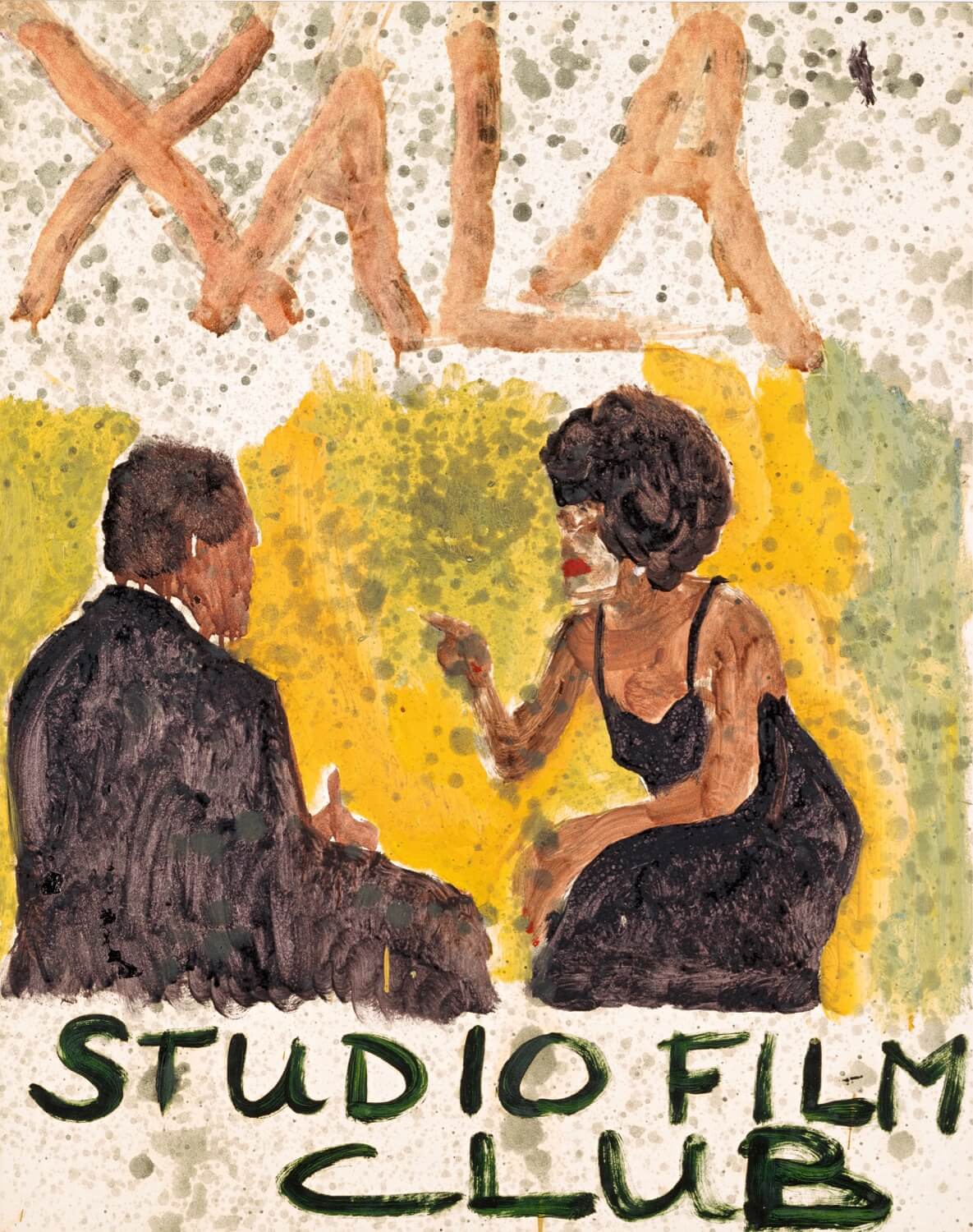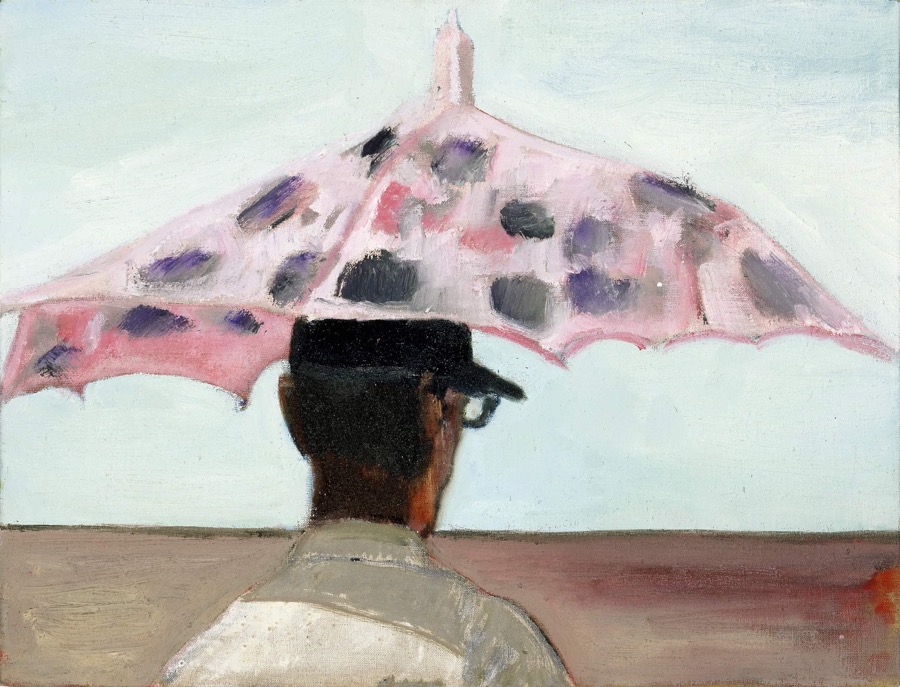Lapeyrouse Wall
Along the cemetery wall of Lapeyrouse
in Port of Spain, Trinidad, he saw this truth:
a fellow walking with a floral umbrella
that seems both parasol and parachute―
all our wishes are still rooted in ground,
but solid as a hydrant on a sill
of the sidewalk. Both urgent and casual,
the painting is in dialect, with its big shoes
and heavy eyeglasses almost a cartoon, but
in the perspective of the wall there
is both infinity and patience,
the qualities that are praised in a Protestant hymn.
The parasol, I’d say, belongs to his dead wife;
it floats him determined, ruminant in the hot sun,
above the street and roofs; he passes the same street
everyday, repetitive as the painting of himself.

In the Heart of Old San Juan
To me, the waking day is Margaret:
down every street, every street corner,
the boulevards brilliant, with one regret;
every memory is now a mourner.
On the day of the reception for her death
Peter came to her house; there was the usual
chaos of friends, faces against the bright earth
of Santa Cruz; daughters, granddaughters.
Margaret was gone but all the streets were hers,
sunlight down White Street down by the Little Carib or
the talkative reflections in the harbor―
all these are her monuments, not paint or verse.

Paramin
She loved to say it and I loved to hear it,
“Paramin,” it had the scent of cocoa in it,
the criss-crossing trunks of leafy gommiers straight
out of Cézanne and Sisley, the road rose then fell fast
into the lush valley where my daughters live.
The name said by itself could make us laugh
as if some deep, deep secret was hidden there
I see it through crossing tree-trunks framed with love
and she is gone but the hill is still there
and when I join her it will be Paramin
for both of us and the children, the mountain air
and music with no hint of what the name could mean,
rocking gently by itself “Paramin,” “Paramin”.

The Studio Film Club, I
In the studio with extra chairs and a projector
he founded a film club; he learnt from it.
From the speed of the racing frames he could not expect the
cuts to appear or not, he learnt to edit.
As in the movie when a light comes on
inside the bank and you suddenly startle the villain
lifting the heist, there’s a man with a pelican
caught in a glare of moonlight, its wings missing.
Or else, like in Casablanca, the loved one
is more obsessed with smoking than with kissing.
Each movie needs its hieroglyphic poster:
the train tracks mean farewell, the engine hissing,
saying just one more whistle and you’ve lost her.
Treachery is the theme, that and tabanca,
tabanca the Creole word for cuckoldry.
Emblem: a Carib and a half-pack of Anchor.

Lapeyrouse Umbrella
Her merciless absence multiplies my thoughts,
while three pouis are blooming on Pigeon Island
above the triangular sails of regatta yachts.
Another glittering day without you; take my hand
and bring me to wherever we were: the empty house
in Petit Valley or the city of Lapeyrouse
where headstones multiply like sails on a Sunday,
where a widower tacks under a pink parasol,
where people think that pain or pan is good for the soul.
You go down Tragarete Road to enter Saint James.
What she has forgotten you learn every day, Peter.
It is a country full of paintable names:
Paramin, Fyzabad, Couva, where the trees rhyme.
She sleeps in the country where there is no time,
as my pen and your brushstroke blend in the one metre.

Published September 15, 2016
From Morning, Paramin, forthcoming in November 2016 from FSG (US), and Faber & Faber (UK).
Excerpted with permission of the author and publishers.
© 2016 Derek Walcott
Le mur de Lapeyrouse
Le long du mur du cimetière de Lapeyrouse
à Port of Spain, Trinidad, il l’a véritablement vu :
un type marchant sous une ombrelle à fleurs
qui semble faire à la fois parasol et parachute –
tous nos vœux sont enracinés au sol,
aussi solidement qu’une borne d’incendie sur un bord
de trottoir. À la fois dans l’urgence et la routine,
le tableau est réalisé dans une sorte de dialecte, avec grosses chaussures
et lourdes lunettes qui font BD, mais
dans la perspective du mur, il y a
à la fois l’infini et la patience,
qualités dont on fait l’éloge dans une prière protestante.
Le parasol, je dirais qu’il appartient à sa défunte épouse ;
il le hisse, décidé, ruminant dans le soleil brûlant,
au-dessus de la rue et des toits ; l’homme passe dans la même rue
tous les jours, se répétant, comme s’il se peignait lui-même.

Au cœur du vieux San Juan
La lever du jour, pour moi, c’est Margaret :
au fil des rues, de chaque coin de rue,
des boulevards éclatants, un seul regret ;
désormais tout souvenir est une pleureuse.
Le jour de ses obsèques, pour la réception,
Peter est venu chez elle : il y avait l’habituel
chaos des amis, têtes penchées sur la terre éclatante
de Santa Cruz ; filles, petites-filles.
Margaret n’était plus là mais toutes les rues lui appartenaient,
le soleil sur White Street du côté de Little Carib
ou les reflets volubiles dans l’eau du port,
voilà ses monuments, ni peinture ni poésie.

Paramin
Elle aimait à le dire et j’aimais à l’entendre,
” Paramin “, il y avait là l’odeur du cacao,
les troncs sens dessus dessous des gommiers feuillus, tout droit
sortis de Cézanne ou Sisley, la route montait puis retombait vite
dans la vallée luxuriante où vivent mes filles.
Ce nom, de lui-même, pouvait nous faire rire
comme si un secret, un très profond secret y était enfoui.
Je le vois, dans l’entrelacs des troncs d’arbres disposés avec amour ;
elle nous a quittés mais la colline, elle, demeure
et quand je la rejoindrai, ce sera le Paramin
pour tous les deux et pour les enfants, l’air de la montagne
et la musique, toujours sans la moindre idée de ce que signifie ce nom
qui swingue, tournant gentiment sur lui-même, ” Paramin “, ” Paramin “.

Studio Film Club, I
Dans l’atelier, avec un projecteur et en rajoutant quelques chaises,
il a créé un ciné-club ; il a appris sur le tas.
La succession des plans, parfois si rapide que ne peuvent
s’anticiper les coupes, l’a initié au montage.
Ainsi, dans le film, quand la lumière se fait
à l’intérieur de la banque et qu’on surprend soudain le méchant
en train de faire son casse, voici un homme avec un pélican
les ailes arrachées, coincé dans l’éclat d’un rayon de lune.
Ou bien encore, dans Casablanca, quand l’être aimé
a davantage envie de fumer que de donner un baiser.
Chaque film a besoin de son affiche hiéroglyphique,
les rails du train signifient les adieux, la locomotive lançant un sifflement :
encore un, et la voilà perdue pour toujours.
Ça parle de trahison, de ça et de tabanca,
tabanca, le mot créole pour le cocuage.
Emblème : une Carib et un demi-pack d’Anchor.

Ombrelle de Lapeyrouse
Son impitoyable absence fait proliférer mes pensées,
tandis que sur Pigeon Island, trois ébéniers fleurissent
au-dessus des voiles triangulaires des bateaux en régate.
Un jour de plus qui brille sans toi ; prends ma main
et emmène-moi partout où nous avons été jadis : la maison vide
à Petit Valley ou Lapeyrouse, ville
où les pierres tombales prolifèrent comme voiles un dimanche,
où un veuf tire des bordées sous un parasol rose,
où les gens pensent que perclusion ou percussions, c’est bon pour l’âme.
Tu descends Tragarete Road pour entrer dans Saint James.
Ce qu’elle a oublié tu l’apprends tous les jours, Peter.
C’est un pays plein de noms qui semblent faits pour la peinture :
Paramin, Fyzabad, Couva, où les arbres font des rimes.
Elle dort dans ce pays où il n’y a pas de temps,
ma plume et ton coup de pinceau se mêlant en un mètre unique.

Published September 15, 2016
Extrait tiré de Paramin, à paraître en novembre 2016 aux éditions Actes Sud.
© 2016 Actes Sud

5 poesie da Morning, Paramin
Written in English by Derek Walcott
Tradotte in italiano da Matteo Campagnoli
Il muro di Lapeyrouse
Lungo il muro del cimitero di Lapeyrouse
a Port of Spain, Trinidad, vide questa verità:
un tizio che cammina con un ombrello a fiori
che sembra sia un parasole sia un paracadute –
i nostri desideri sono ancora radicati nella terra,
ma stabili come un idrante sul ciglio
del marciapiede. Insieme urgente e rilassato,
il dipinto è in dialetto, con le sue scarpe grosse
e gli occhiali spessi quasi un fumetto, ma
nella prospettiva del muro ci
sono sia infinità che pazienza;
le qualità lodate in un inno protestante.
Il parasole, direi, è della moglie defunta;
lui lo fa fluttuare risoluto, pensieroso sotto il sole cocente,
sopra le strade e i tetti; passa dalla stessa strada
ogni giorno, ripetitivo come il dipinto di se stesso.

Nel cuore della vecchia San Juan
Per me, il giorno che si sveglia è Margaret:
su ogni strada, a ogni angolo di strada,
i viali lucenti, con un solo rimpianto;
ogni ricordo ora è in lutto.
Il giorno del ricevimento per la sua morte
Peter è venuto a trovarci. C’era il solito
viavai di amici, facce sullo sfondo acceso
della terra di Santa Cruz; figlie, nipoti.
Margaret se n’era andata ma tutte le strade erano sue,
il sole giù a White Street giù vicino al Little Carib o
i riflessi loquaci nel porto –
sono questi i suoi monumenti, non la pittura o i versi.

Paramin
A lei piaceva dirlo e a me sentirlo,
“Paramin”, conteneva l’aroma del cacao,
i tronchi intersecati dei gommiers frondosi presi di peso
da Cézanne e Sisley, la strada saliva poi scendeva rapida
nella valle rigogliosa dove vivono le mie figlie.
Bastava anche il solo nome a farci ridere
come se nascondesse chissà quale profondo segreto.
Lo vedo tra i tronchi intersecati incorniciati dall’amore
e lei se n’è andata ma la collina è ancora lì
e quando la raggiungerò sarà Paramin
per noi due e i bambini, l’aria di montagna
e una musica che non ha idea di cosa significhi quel nome
che si culla dolcemente da sé, “Paramin”, “Paramin”.

Studio Film Club, I
Nello studio con qualche sedia in più e un proiettore
aveva fondato un film club, da cui ha imparato.
Dalla velocità dei fotogrammi in corsa non poteva aspettarsi
dove arrivassero i tagli, ha imparato il montaggio.
Come in quel film quando si accende una luce
nella banca e all’improvviso sorprendi il cattivo
che solleva il bottino, c’è un uomo con un pellicano
colto in un bagliore lunare, senza le ali.
Oppure, come in Casablanca, l’amato
è più interessato alle sigarette che ai baci.
Ogni film ha bisogno del suo poster geroglifico:
i binari significano addio, la locomotiva che sbuffa
sta dicendo un altro solo fischio e l’hai persa.
Il soggetto è il tradimento, quello e tabanca,
tabanca la parola creola per le corna.
Emblema: una Carib e mezzo pacchetto di Anchor.

Ombrello a Lapeyrouse
La sua assenza spietata moltiplica i miei pensieri,
mentre tre pouis sbocciano a Pigeon Island
sopra le vele triangolari delle barche da regata.
Un altro giorno sfolgorante senza di te; prendimi per mano
e portami ovunque eravamo: la casa vuota
nella Petit Valley o la città di Lapeyrouse
dove le lapidi si moltiplicano come vele di domenica,
dove un vedovo bordeggia sotto un parasole rosa,
dove la gente pensa che pene o pan, fa bene all’anima.
Scendi per Tragarete Road verso Saint James.
Ciò che lei ha scordato tu lo impari ogni giorno, Peter.
È un paese pieno di nomi fatti per essere dipinti:
Paramin, Fyzabad, Couva, dove gli alberi rimano.
Lei dorme in quel paese dove non c’è il tempo,
mentre la mia penna e le tue pennellate si fondono nell’unico metro.

Published September 15, 2016
© 2016 Derek Walcott
© 2016 Matteo Campagnoli

Other
Languages

This is what you can call a great gift for Specimen’s launch! Derek Walcott, winner of the 1992 Nobel Prize in Literature, has given us five unpublished poems which are also a world premiere of his latest book, Morning, Paramin, a collection of 51 poems inspired by Peter Doig’s paintings. Originally conceived by publisher and gallerist Harry Jancovici, Morning Paramin is due out in November 2016 from FSG in the US, from Faber & Faber in the UK, and from Actes Sud in France, under the title Paramin, in Pierre Vinclair’s translation. Our deepest thanks to Derek, then, and to Harry and all the publishers for granting us permission to print the original poems and the French translations, to Peter Doig for the reproductions of his paintings, and to Matteo Campagnoli for the Italian versions.
Non poteva esserci regalo migliore per l’inaugurazione di Specimen! Derek Walcott, Premio Nobel per la letteratura 1992, ci ha donato 5 poesie inedite che sono anche un’anteprima mondiale del suo ultimo libro, Morning, Paramin, una raccolta di 51 liriche ispirate ad altrettanti quadri del pittore scozzese Peter Doig, da anni residente a Trinidad. Nato da un’intuizione dell’editore e gallerista Harry Jancovici, il libro uscirà a ottobre del 2016 negli Stati Uniti per FSG, in Inghilterra per Faber & Faber, e in Francia per Actes Sud – col titolo Paramin – nella traduzione di Pierre Vinclair. Grazie dunque a Derek, a Harry e agli editori per averci concesso di riprodurre gli originali e le versioni francesi, a Peter Doig per le immagini dei suoi quadri, e a Matteo Campagnoli per le versioni italiane.

Your
Tools
